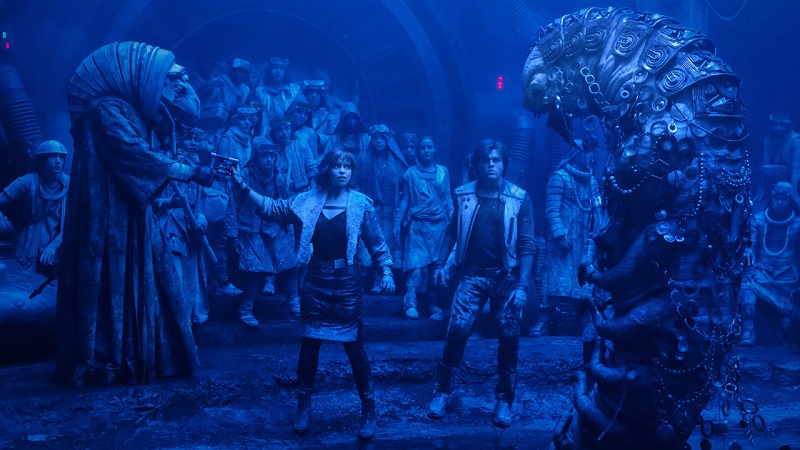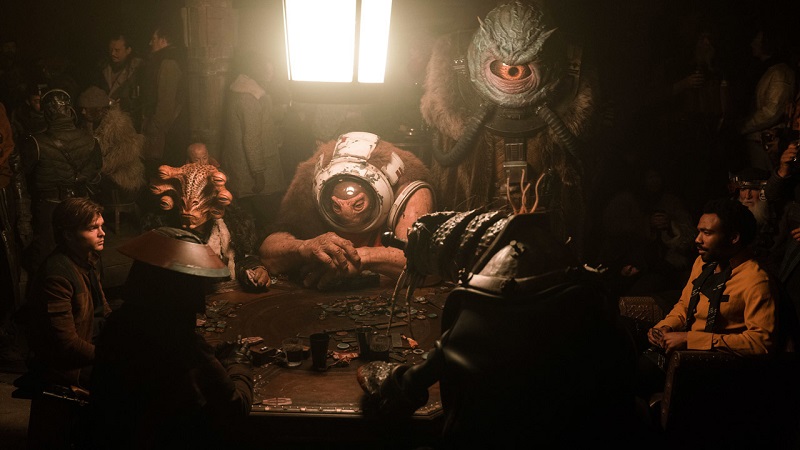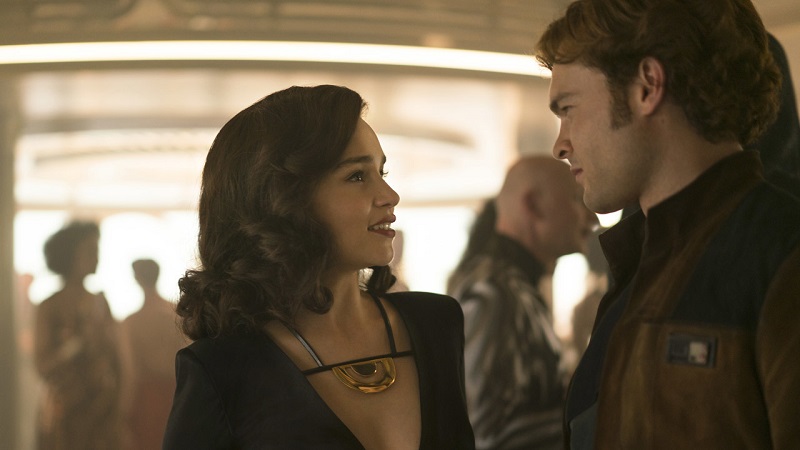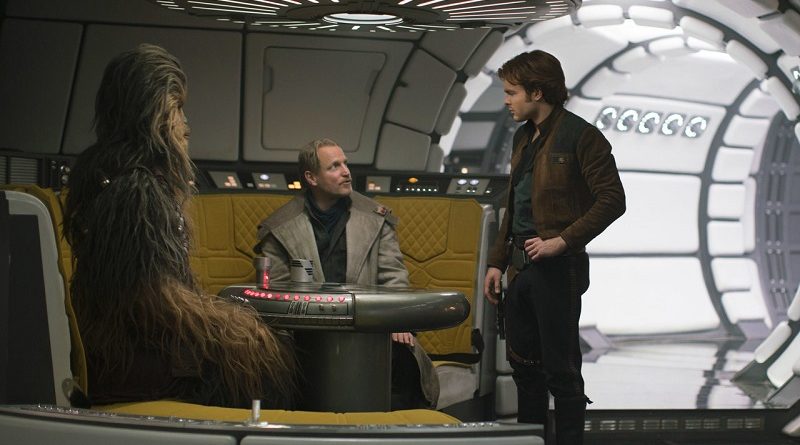The Hero’s Journey for Han in SOLO
From the beginning Star Wars has drawn upon the Hero’s Journey as a foundational storytelling structure for its films, particularly the movies focusing on origin stories for central characters. George Lucas famously built Luke’s path in A New Hope around the monomyth framework identified in the work of academic Joseph Campbell, who praised Lucas’ adaptation of the classic mythical elements into a modern space opera. In The Force Awakens, Jakku scavenger Rey and First Order deserter Finn undertake parallel Hero’s Journey arcs, with their adventures more directly following the stages of the contemporary cinematic model described by screenwriter Christopher Vogler.
Like its predecessors, Solo: A Star Wars Story also relies upon the Hero’s Journey for the character progression and story beats of Han Solo’s formative experiences a decade before the events of A New Hope. The visual design and filmmaking techniques in Solo were deliberately crafted to evoke the spirit of the 1960s and ’70s, allowing Solo to feel as though it actually were a product of the years preceding the release of the original Star Wars. So too Han’s character journey in the film seems intentionally more reliant, especially in the third act, on the traditional Campbell model that influenced the young Lucas. Both as a movie and as a story, then, Solo is in a sense a period piece derived from the inspirations and origins of Star Wars rather than looking toward its future.
Act One: Departure
Solo begins with an extended prologue, set three years before the rest of the story. This Ordinary World marks a contrast with Luke and Rey: rather than a desolate world far from the bright center of the galaxy, Corellia is a powerful world in the Core and an industrial powerhouse. An Imperial Star Destroyer under construction parallels the fateful events over Tatooine and the wreckage of the starship graveyard on Jakku. For Han himself, though, his life is not so different from theirs. He too is an orphan who dreams of flying among the stars. Stuck in his role as a scrumrat, he carries out the commands of Lady Proxima; one of the other scrumrats even mentions “a full portion” as a reward for a successful acquisition via thievery on her behalf.
 When Han and Qi’ra discuss their dream of a life beyond the White Worms, they do not imagine feats of heroism or gallant adventures, but simply the independence of owning their own starship and the autonomy to choose where to fly it. Han’s pilfered vial of coaxium, all that remains of a deal gone bad, inspires him to stand up to Lady Proxima. The speeder chase, narrowly escaping Moloch and his Corellian hounds, demonstrates both Han’s aptitude as a driver and his questionable judgment in taking risks. Their plan to bribe the security officer at the spaceport checkpoint works – except that Moloch’s goons grab Qi’ra before she can pass through the barrier with Han. Watching her dragged away, he promises to return for her.
When Han and Qi’ra discuss their dream of a life beyond the White Worms, they do not imagine feats of heroism or gallant adventures, but simply the independence of owning their own starship and the autonomy to choose where to fly it. Han’s pilfered vial of coaxium, all that remains of a deal gone bad, inspires him to stand up to Lady Proxima. The speeder chase, narrowly escaping Moloch and his Corellian hounds, demonstrates both Han’s aptitude as a driver and his questionable judgment in taking risks. Their plan to bribe the security officer at the spaceport checkpoint works – except that Moloch’s goons grab Qi’ra before she can pass through the barrier with Han. Watching her dragged away, he promises to return for her.
Literally walled off from his Ordinary World, Han must reinvent himself quickly to avoid ending up back in the hands of the White Worms, too. His Call to Adventure is not mythical but self-referentially modern: an advertisement, in the form of Imperial propaganda posters and a recruitment video in a style familiar to fans of Star Wars Rebels. Believing the Academy would provide him the training to become an ace pilot, and thereby a means to return to Corellia and rescue Qi’ra, he enlists in the Imperial war machine.
Like FN-2187, Han is bestowed with a name not of his choosing. Like Finn, Han’s conscience will not permit him to follow the orders of his tyrannical commanders. This results in his Refusal of the Call, rejecting the path forward that had been offered to him. Han declares that he was expelled from the Academy for having a mind of his own. Amid the muddy trenches, Han mouths off to a superior officer by correctly pointing out that, from the perspective of the indigenous Mimbanese, the Imperial invaders are the hostiles.
 The arrival of Beckett’s crew changes Han’s destiny. Campbell calls this stage Supernatural Aid, which suits the delivery of surprising revelations by “Old Ben” Kenobi in his hut on Tatooine in A New Hope and the appearance of two Jedi Knights to secure Queen Amidala’s safe passage to Coruscant in The Phantom Menace. In the same role than Han later served for Rey, Beckett is not a Jedi or other individual strong in the Force, but rather a mentor who guides young Solo to learn important lessons necessary for surviving in the Extraordinary World of adventure. Just as Han is initially reluctant to help Rey, Beckett rejects Solo’s desire to join them. Where Rey and Finn play to Han’s guilt about the past in beseeching him to aid them in returning BB-8 to the Resistance, Solo attempts to blackmail Beckett – and realizes too late that the older man’s experience makes him far from vulnerable. And just as Rey proves her value in helping evade the gangs and rathars before escaping in the Millennium Falcon, Solo’s escape from Imperial incarceration impresses Beckett and Rio enough to change their minds about him.
The arrival of Beckett’s crew changes Han’s destiny. Campbell calls this stage Supernatural Aid, which suits the delivery of surprising revelations by “Old Ben” Kenobi in his hut on Tatooine in A New Hope and the appearance of two Jedi Knights to secure Queen Amidala’s safe passage to Coruscant in The Phantom Menace. In the same role than Han later served for Rey, Beckett is not a Jedi or other individual strong in the Force, but rather a mentor who guides young Solo to learn important lessons necessary for surviving in the Extraordinary World of adventure. Just as Han is initially reluctant to help Rey, Beckett rejects Solo’s desire to join them. Where Rey and Finn play to Han’s guilt about the past in beseeching him to aid them in returning BB-8 to the Resistance, Solo attempts to blackmail Beckett – and realizes too late that the older man’s experience makes him far from vulnerable. And just as Rey proves her value in helping evade the gangs and rathars before escaping in the Millennium Falcon, Solo’s escape from Imperial incarceration impresses Beckett and Rio enough to change their minds about him.
But it is no simple escape: for Han it also involves the stage of the journey that Campbell calls The Belly of the Whale, a moment of mortal peril that tests him before his new life truly begins. Thrown in the cell with the “beast,” Han’s mangled Shyriiwook is sufficient to forge an unlikely alliance with the enraged imprisoned Chewbacca – though their “secret battle of pretend” perhaps is not quite so fake as Han had intended.
Crossing the First Threshold represents the act of leaving the Ordinary World behind to embark on the adventure in the Extraordinary World. Han and Chewie leave behind the mud and imprisonment of Mimban, with their communal showering off representing a baptism into their new existence. Without a Poe Dameron to expunge the name Han was given, though, the moniker Solo endures. Their newfound cleanliness matches the pristine natural beauty of mountainous Vandor, where the newly acquired AT-Hauler will facilitate the intended heist. Though they hope to earn enough money to secure their independence after the job is over, Han and Chewie acknowledge on the vessel’s gangway that their lives have changed forever.
Act Two: Initiation
In Campbell’s model, the Road of Trials encompasses the series of challenges that test the character in the Extraordinary World, each one playing a part in the metamorphosis that transforms him into the Hero will be at the Journey’s end. In Solo, this includes everything that transpires on Vandor as well as the coaxium theft on Kessel.
 These events shape Han’s path in important ways. He bonds with Beckett’s crew around a campfire the night before the train heist, so that he understands what Beckett loses when the mission goes wrong. Rio’s death gives Han a chance to prove his worth as a pilot – and the advice that it’s no good to die alone, as Beckett ultimately does. Han ignores Beckett’s command rather than risk everyone’s death in the hope of absconding with the coaxium, then demonstrates his sense of honor by pledging to help Beckett make things square with Crimson Dawn. Aboard Dryden’s yacht he goes in even deeper with his commitment once he realizes Qi’ra is tied up in the syndicate, too. In losing the first sabacc game to Lando at Fort Ypso, Han learns the hard way that not everyone is as honorable as he is. During the coaxium theft on Kessel, he further repudiates Beckett’s preferred methodology of sticking to the plan. He also reaffirms his integrity, accepting that it is more important for Chewie to free his fellow Wookiees than to continue with the plan – though Chewie soon returns the favor, helping Han complete the delivery of the canisters to the Falcon. A truly selfish scoundrel would have left Lando behind after his foolhardy attempt to retrieve the damaged L3 got the sportsman shot himself, too, but Han instead rushes into the firefight to save Lando. Seeing that act of bravery and honor, Chewie declines to leave with the other Wookiees and stays with his new friend Han.
These events shape Han’s path in important ways. He bonds with Beckett’s crew around a campfire the night before the train heist, so that he understands what Beckett loses when the mission goes wrong. Rio’s death gives Han a chance to prove his worth as a pilot – and the advice that it’s no good to die alone, as Beckett ultimately does. Han ignores Beckett’s command rather than risk everyone’s death in the hope of absconding with the coaxium, then demonstrates his sense of honor by pledging to help Beckett make things square with Crimson Dawn. Aboard Dryden’s yacht he goes in even deeper with his commitment once he realizes Qi’ra is tied up in the syndicate, too. In losing the first sabacc game to Lando at Fort Ypso, Han learns the hard way that not everyone is as honorable as he is. During the coaxium theft on Kessel, he further repudiates Beckett’s preferred methodology of sticking to the plan. He also reaffirms his integrity, accepting that it is more important for Chewie to free his fellow Wookiees than to continue with the plan – though Chewie soon returns the favor, helping Han complete the delivery of the canisters to the Falcon. A truly selfish scoundrel would have left Lando behind after his foolhardy attempt to retrieve the damaged L3 got the sportsman shot himself, too, but Han instead rushes into the firefight to save Lando. Seeing that act of bravery and honor, Chewie declines to leave with the other Wookiees and stays with his new friend Han.
Along the way, Solo also takes Han through several other stages of Campbell’s monomyth framework. His reunion with Qi’ra is the Meeting With the Goddess, with her beauty and fond affection reminding him of exactly what he has been striving to regain. Minutes later, though, her role in his arc shifts to the Woman as Temptress: when his goal should be nothing more than figuring out a way to repay the debt to Crimson Dawn and escape the mortal peril he now faces in the Extraordinary World, instead Han is focused on his feelings for Qi’ra. By trying to impress her and using their past connection to induce her contributions to the formulation of a plan, Han inadvertently not only puts himself deeper in danger but also pulls Qi’ra into the vortex, as well, when Dryden dispatches her – with death the price of failure – to join the mission to Kessel. Leaving Vandor on the Falcon, Han experiences an Atonement With the Father, the son of a factory worker now leaping into hyperspace aboard a YT-1300 freighter like the ones his father had helped to manufacture.
 The second act in Campbell’s model ends with the Apotheosis, completing the metamorphosis, and the Ultimate Boon, the accomplishment of the quest. Lando’s injury and grief creates the opening for Han to take the controls of the Millennium Falcon for the first time – facing stakes no less than undertaking the perilous exit journey of the Kessel Run. Soon after Chewie becomes his co-pilot, forging a dynamic duo that will last for four decades. With Imperial forces in pursuit and time running out to maintain a safe temperature for the volatile unrefined coaxium, Han acts true to form with a spontaneous and not-very-well-thought-out decision to simply fly into the Akkadese Maelstrom and figure out a shortcut once they’re inside. Somehow it works, thanks to some great flying and an assist from L3’s central processor uploaded into the Falcon’s navigational computer – the Magic Flight that Campbell locates in the third act but previous Star Wars films, including A New Hope’s Death Star escape about the Falcon, typically place earlier in the story. Han has become the incredible starpilot he had dreamed of being, and the crew escapes the clutches of the Maw’s gravity well with a staggeringly valuable quantity of coaxium.
The second act in Campbell’s model ends with the Apotheosis, completing the metamorphosis, and the Ultimate Boon, the accomplishment of the quest. Lando’s injury and grief creates the opening for Han to take the controls of the Millennium Falcon for the first time – facing stakes no less than undertaking the perilous exit journey of the Kessel Run. Soon after Chewie becomes his co-pilot, forging a dynamic duo that will last for four decades. With Imperial forces in pursuit and time running out to maintain a safe temperature for the volatile unrefined coaxium, Han acts true to form with a spontaneous and not-very-well-thought-out decision to simply fly into the Akkadese Maelstrom and figure out a shortcut once they’re inside. Somehow it works, thanks to some great flying and an assist from L3’s central processor uploaded into the Falcon’s navigational computer – the Magic Flight that Campbell locates in the third act but previous Star Wars films, including A New Hope’s Death Star escape about the Falcon, typically place earlier in the story. Han has become the incredible starpilot he had dreamed of being, and the crew escapes the clutches of the Maw’s gravity well with a staggeringly valuable quantity of coaxium.
Act Three: Return
In Vogler’s cinematic model for the Hero’s Journey, the third act builds on the end of the second, frequently increasing the tension for another climactic action sequence to bring the movie to a rousing finish. In Campbell’s traditional monomyth, on the other hand, the focus is not added physical peril but rather the difficulty for the Hero in synthesizing the experiences of the Extraordinary World with the reality of the Ordinary World to which he is return after achieving the objective of his quest. Solo adopts the perspective of the latter, with only minimal combat in the final act and the emphasis instead on the choices Han faces.
Mirroring the initial Refusal of the Call is the Refusal of the Return. Having delivered the raw coaxium to the Savereen refinery, Han has accomplished his goal: Dryden Vos will receive the full quantity of hyperfuel he was promised, and consequently Han, Chewie, and Beckett not only will be spared from Crimson Dawn’s wrath but also lucratively compensated with their shares, free to move on with their lives. The truth revealed by Enfys Nest, however, has changed Han’s perspective. He is no longer willing to hand over the coaxium to the barbaric syndicate, and concocts a scheme to dupe the crime lord. If his plan fails, Han won’t just lose his independence, but his life.
Once more aboard Dryden’s yacht, Han proves that he has learned the lessons of his adventure in the Extraordinary World. He has anticipated both Dryden’s mistrust and Beckett’s betrayal. The Rescue From Without takes the form of Han’s collaboration with Enfys Nest and the Savarinian locals, who dupe Dryden’s goons at the refinery – leaving him undefended in his office, where Beckett’s blaster finishes off the change in the odds. Trusting Chewie to safeguard the coaxium, Han lets Beckett leave with the hyperfuel so that, be believes, he and Qi’ra can liberate her from servitude to Dryden and Crimson Dawn. Once Dryden is slain, Han kisses Qi’ra. In that moment he is Crossing the Return Threshold, confident that his time amid the machinations of the criminal syndicates in the Extraordinary World has come to an end, and that he and Qi’ra can now be together for the independence among the stars they had always dreamed of.
 Back on the sandy soil of Savareen, Han shows that he has become the Master of Two Worlds. First the movie briefly takes a page from Vogler, who calls the final stage either Denouement or the Return With the Elixir – here, the shot of Han and Chewie walking up the slope to deliver the coaxium to Enfys Nest, as promised. In allowing her incipient rebellion against oppression, both criminal and Imperial, to acquire the boon of his quest, Han proves himself to be the selfless “good guy” that Qi’ra had christened him, resigned to a far more mundane life in the Ordinary World rather than the wealth that the share from Dryden would have provided him. At the same time, Han now understands enough about the dangers of the Extraordinary World to outmaneuver Dryden in his yacht office – and to anticipate Beckett’s motivation on atop the seashore cliff, firing a fatal shot before the erstwhile mentor can fire his. The only person Han has misjudged is Qi’ra, and he watches sadly as she departs in the Crimson Dawn yacht instead of joining him for a life together. With a hand on the shoulder, however, Chewie reminds Han that he is not alone.
Back on the sandy soil of Savareen, Han shows that he has become the Master of Two Worlds. First the movie briefly takes a page from Vogler, who calls the final stage either Denouement or the Return With the Elixir – here, the shot of Han and Chewie walking up the slope to deliver the coaxium to Enfys Nest, as promised. In allowing her incipient rebellion against oppression, both criminal and Imperial, to acquire the boon of his quest, Han proves himself to be the selfless “good guy” that Qi’ra had christened him, resigned to a far more mundane life in the Ordinary World rather than the wealth that the share from Dryden would have provided him. At the same time, Han now understands enough about the dangers of the Extraordinary World to outmaneuver Dryden in his yacht office – and to anticipate Beckett’s motivation on atop the seashore cliff, firing a fatal shot before the erstwhile mentor can fire his. The only person Han has misjudged is Qi’ra, and he watches sadly as she departs in the Crimson Dawn yacht instead of joining him for a life together. With a hand on the shoulder, however, Chewie reminds Han that he is not alone.
Solo concludes with a brief epilogue that also serves as Campbell’s Freedom to Live. Han and Chewie have tracked down Lando – but this time Solo is ready for Calrissian’s cheating. Winning the Falcon “fair and square,” Han and Chewie launch into space and prepare for their next lucrative endeavor. Though the Star Wars fans in the audience know how getting wrapped up in the orbit of a big shot gangster on Tatooine is going to work out for Han by the time another decade has passed, in those final moments of Solo only the promise of the future is stretched out ahead of him.










